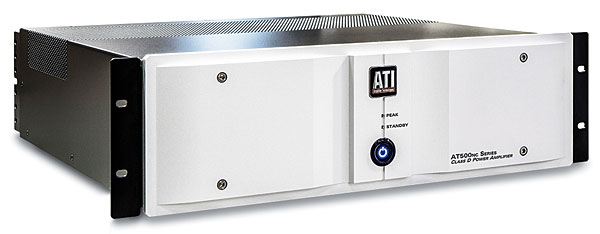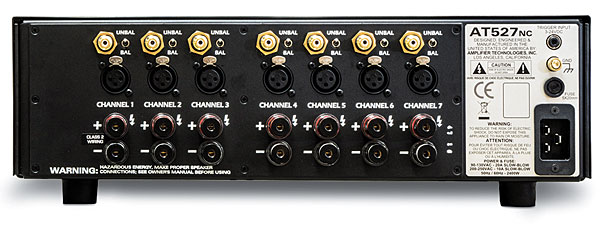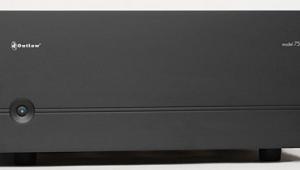I bought the three channel 523 to power kef reference 1 & 2c, and i couldn't be happier. My dealer gave me a good deal, as always, and this has been a value product to me that aside from price is the best I can ask for without going extreme. Happy to embrace Class D!
ATI AT527NC and AT524NC Amplifiers Review

AT A GLANCE
Plus
Very powerful
Natural and balanced
Made in the U.S.A.
Minus
LEDs are too bright
THE VERDICT
The days of looking down on Class D amps are over.
Two and a half years ago, I reviewed my first ATI amplifier, and to say I was impressed would be an understatement. The ATI Signature AT6005 five-channel amp set a new benchmark for its designer, Morris Kessler—to the point where he put his John Hancock on the faceplate.
Last year, S&V editor-at-large Bob Ankosko sat down with Kessler to talk about his design philosophy over the years, and the subject of Class D amps was broached. Kessler mentioned that his current designs were all Class A/B, but he was following the developments of Class D very closely—though the initial efforts in this area didn’t meet his high standards because frequency response varied greatly as the impedance of the speaker changed. He hinted at the time that he may have finally found a Class D solution that he could deem acceptable, which turned out to be the latest Hypex Ncore modules.
These modules are from Bruno Putzeys, one of the next generation of audio engineers. His company, Hypex Electronics (located in the Netherlands), burst onto the scene in 2001 with their first Class D amps, named UcD. Ten years later, his designs developed into the Ncore modules, which combine the stability of the progenitor UcD with improved load independence, lower distortion, and lower output impedance. This was achieved not only via improved circuitry but also through advancements in understanding the underlying theory and mathematical models involved to implement it.
Kessler believes that the Hypex Ncore modules are arguably the best Class D amplifiers available because their measurable performance is very good, and they compare well with linear amps. With their efficiency approaching 90 percent, leading to less heat generation than is typical of an equally powered linear Class A/B design, the chassis can be 25 percent smaller and lighter. For those reasons and others, Kessler chose the modules for his new line of Class D power amps, the AT5XXNC series. But can they live up to the hype?

The Details
I currently run a 7.1.4 setup that supports both Dolby Atmos and DTS:X, so in order to power all 11 channels, ATI sent me two versions of their Class D amp: an AT527NC to drive my three front speakers and four surround speakers and an AT524NC to drive my four overhead speakers. The AT5XXNC series comes in two power configurations. The AT52XNC amps (including the models reviewed here) are rated at 200 watts RMS per channel into 8 ohms (300 watts into 4 ohms) and are available with two to eight channels. The AT54XNC amps, which use two Ncore modules per channel in a differential bridged output configuration, deliver 500 watts RMS per channel into 8 ohms (900 watts into 4 ohms) and are available with two, three, or four channels. The first “X” in the model number of an AT5XXNC series amp refers to the number of modules (two or four), and the second refers to the number of channels (two to eight).
My current speaker configuration consists of three M&K Sound S-150s (4 ohms nominal) across the front and four SS-150s (4 ohms nominal) for the surround speakers, together with four Atlantic Technology IC-6 OBA (6 ohms nominal) in-ceiling speakers for the overheads. Low bass support is provided by SVS PC-Ultra and Hsu Research VTF-15H MK2 subwoofers.
My reference five-channel amp is the John Curl–designed Parasound Halo A 51, which weighs 80 pounds and is a back-breaker to get in and out of my A/V rack. My rear surrounds and overhead channels are powered by a Parasound ZoneMaster 1250, bridged into six channels. I already owned the A 51 when I installed my Atmos system back in 2015, and it was difficult finding a six-channel amp that didn’t break the bank or weigh more than 100 pounds. The A 51 offers 400 watts per channel into 4 ohms, while the bridged ZoneMaster is rated at 200 watts per channel (also into 4 ohms).
Setup and Specs
Unboxing the two ATI amplifiers was a pleasure, given their relatively light weight of 65 pounds for the seven-channel model and 40 pounds for the four-channel. The faceplates are identical, with a modest-sized ATI logo in the center and two LEDs sitting in vertical alignment underneath it; the lower LED indicates Standby mode, and the upper one signifies that Peak power has been reached. At the bottom is an illuminated power switch that pulsates slowly when inactive and glows solid when the amp is triggered on. My only gripe about the LEDs is that they’re quite bright in a darkened room, but they’re easily covered by electrical tape or other means.

The rear panel of each amp has both unbalanced RCA inputs and balanced XLR connectors (with toggle switches to choose which input method you prefer) and corresponding speaker outputs that support banana plugs—all of which makes setup a breeze. If you want to hand-wire each speaker, the binding posts give enough space to maneuver in, so even thicker fingers won’t struggle too much. Finishing things off is a ground terminal, a 12-volt trigger, and a 20A IEC power connector.
Under the hood, each amp features a plethora of technologies that should please both casual listeners and audiophiles alike. As stated earlier, each model has Ncore Class D amplifier modules (the ones here are the NC-500), coupled with an ATI-designed custom analog gain stage and large linear power supply. The AT527NC boasts two toroidal transformers, wound by ATI in their Southern California factory, while the AT524NC has one. [Editor’s Note: We ran measurements for only the seven-channel model; see Test Bench.—RS] This product line is the first of ATI’s amplifiers to tout a microprocessor for control of turn-on delay. Also onboard is a new “sleep” circuit that activates when the amp receives no input signal for a period of 10 minutes. If that occurs, power is removed from the output modules, and the front-panel LED begins to flash slowly, but as soon as an audio signal is detected on any channel, normal playback occurs instantaneously. Additionally, there’s automatic AC voltage recognition and configuration. And the amps are manufactured and assembled here in the States.
- Log in or register to post comments

In the current issue (June) is an interview w/ Putzeys and it says the full one is on this site, but I'm not finding or seeing it anywhere. Anyone reading know anything?

It's great to see a manufacturer (that I understand also made amplifiers for some well-known brand names) introduce a model/line that offers higher-end aspirations -i.e sound quality(according to the reviewer's sentiments)
I say this because, rewinding the years back to the late 1980's, ATI had some amplifiers that were anything but open, transparent, accurate; I vividly recall that the amplifier made every single recording (that I knew was vastly different in tonality -as most are)sound the same. indicating some serious colorations. It must have been so obvious, memorable (not in the terribly celebratory category) for me to note and recall this decades later.
In any case (and as with all other makers), having the right skill-set (or finding those that do) can pay great dividends as apparently it has here.
I look forward to evaluating the multi-channel offerings from ATi -this review helping narrow the field.
peter jasz































































